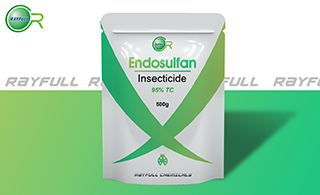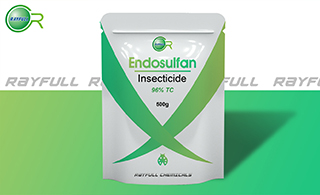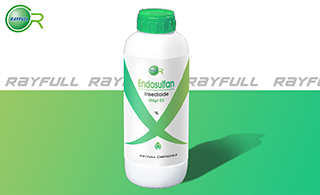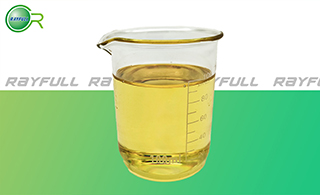Endosulfan
    硫丹 硫丹
Introduction: Endosulfan is a chlorinated hydrocarbon insecticide of the cyclodiene subgroup which acts as a contact poison in a wide variety of insects and mites. It can also be used as a wood preservative. It is used primarily on food crops like tea, fruits, vegetables and on grains. The commercial product is made up of a mixture of two separate parts (isomers): the alpha and beta configurations. Endosulfan will be considered as a single (homogenous) product unless otherwise stated in this profile.
Common name: Endosulfan
Another name: Benzoepin; Thiodan; Thiosulfan; Thionex; Chlorthiepin; Insectophene; Rasayansulfan; Devisulphan; Endosulphan; Beosit; Endocel; Endotaf; Hildan; Sialan; Thifor; Thimul; Tionex; Tiovel; Malix; etc.
Chemical name:
1,4,5,6,7,7-hexachloro-8,9,10-trinorborn-5-en-2,3-ylenebismethylene sulfite
Empirical formula: C9H6Cl6O3S
Structural formula:

Mol. Weight: 406.93 g/mol
CAS No.: 115-29-7
Specifications
Leading Endosulfan supplier
Endosulfan 95% TC
Endosulfan 96% TC
Endosulfan 350 g/L EC
Endosulfan 20% WP
Packing:
BULK PACKING
Powder: 25kg/Bag, 25kg/Drum, 50kg/Drum etc.
Liquid: 200L/Drum, 20L/Drum, 10L/Drum etc.
SMALL PACKING
Powder: 1kg/Alu bag, 500g/Alu bag, 200g/Alu bag, 100g/Alu bag, 50g/Alu bag, 15g/Alu bag etc.
Liquid: 5L/Drum, 1L/Bottle, 500ml/Bottle, 250ml/Bottle, 100ml/Bottle, 50ml/Bottle etc.
Customerized packing label
Endosulfan FAO standard
Professional registration
HAZARDS IDENTIFICATION
Hazard statement(s)
H300: Fatal if swallowed.
H312: Harmful in contact with skin.
H330: Fatal if inhaled.
H400: Very toxic to aquatic life.
H410: Very toxic to aquatic life with long lasting effects.
Precautionary statement(s)
P260: Do not breathe dust/fume/gas/mist/vapors/spray.
P264: Wash ... thoroughly after handling.
P270: Do not eat, drink or smoke when using this product.
P271: Use only outdoors or in a well-ventilated area.
P273: Avoid release to the environment.
P280: Wear protective gloves/protective clothing/eye protection/face protection.
P284: [In case of inadequate ventilation] Wear respiratory protection.
P301 +P310: IF SWALLOWED: Immediately call a POISON CENTER/doctor/...
P302+P352: IF ON SKIN: wash with plenty of water.
P304+P340: IF INHALED: Remove victim to fresh air and keep at rest in a position comfortable for breathing.
P310: Immediately call a POISON CENTER or doctor/physician.
P312: Call a POISON CENTER or doctor/... if you feel unwell.
P320: Specific treatment is urgent (see ... on this label).
P321: Specific treatment (see ... on this label).
P322: Specific measures (see ...on this label).
P330: Rinse mouth.
P363: Wash contaminated clothing before reuse.
P391: Collect spillage.
P403 + P233: Store in a well-ventilated place. Keep container tightly closed.
P405: Store locked up.
P501: Dispose of contents/container to.
Supplemental Hazard Statements: none.
MAMMALIAN TOXICOLOGY
Acute toxicity: 1) Acute oral LD50 for rats is 38 mg/kg. 2) Acute dermal LD50 for rats is >500 mg/kg. 3) Acute inhalation toxicity LC50 (4 h) for rats is 0.013 mg/l. 4) Skin irritation: Non-irritating to skin (rabbits). 5) Eye irritation: Non-irritating to eyes (rabbits). 6) Skin sensitization for guinea pig: Not a skin sensitiser.
NOEL: (2 y) for rats is 0.6 mg/kg/day, (78 w) for mice is 0.58 mg/kg/day, (1 y) for dogs is 0.57 mg/kg/day. Other Not genotoxic.
ADI (JMPR) 0-0.006 mg/kg b.w. [1998, 1989]
Classification:
WHO Classification: II (Moderately hazardous)
EC Risk Classification: T+ - Very toxic: R26/28; Xn - Harmful: R21; N - Dangerous for the environment: R50, R53.
US EPA Classification (formulation): I (Danger - Highly toxic)
ECOTOXICOLOGY
Effect on birds: Acute oral LD50 for Mallard is >111 mg/kg. Effect on fish: Acute LC50 (96 h) for Rainbow trout is 0.002 mg/l. Effects on aquatic invertebrates: Acute EC50 (48 h) for Daphnia magna is 0.44 mg/l. Effects on algae: Acute 72 hour EC50 for Anabaena doliolum is 2.15 mg/l. Effects on bees: Contact acute (48 h) LD50 is >7.81 μg/bee. Effects on earthworms: Acute 14 day LC50 is >14 mg/kg.
ENVIRONMENTAL FATE
EHC 40 (WHO, 1984). Animals The principal route of elimination is faeces; most of the radioactivity is excreted within the first 48 hours. The amounts excreted are independent of dose level, number of dosages and isomerism. There are indications of species-specificity. Residues of endosulfan accumulate in the kidneys rather than in fat. Elimination from the kidneys takes place with DT50 7 d, but there is no sign of accumulation in the kidneys even after long-term feeding. Endosulfan is metabolised rapidly in mammalian organisms to less-toxic metabolites and to polar conjugates. Plants The plant metabolites (mainly endosulfan sulfate) were also found in animals and have thus been investigated from a toxicological point of view. 50% of residues are lost in 3-7 days (depending on plant species). Soil/Environment Endosulfan (alpha- and beta-) is degraded in soil with DT50 30-70 d. The main metabolite usually found was endosulfan sulfate, which is degraded more slowly and is, for this reason, the most important metabolite. DT50 for total endosulfan (alpha- and beta- endosulfan and endosulfan sulfate) in the field is 5-8 mo. No leaching tendency was observed. Koc 3000-20 000; Kd <3%.
Usage: Endosulfan was developed by Hoechst AG (now Bayer Crop Science). Endosulfan is a chlorinated hydrocarbon insecticide and acaricide of the cyclodiene subgroup which acts as a poison to a wide variety of insects and mites on contact. Although it may also be used as a wood preservative, it is used primarily on a wide variety of food crops including tea, coffee, fruits, and vegetables, as well as on rice, cereals, maize, sorghum, or other grains.
Application: Biochemistry Antagonist of the GABA receptor-chloride channel complex. Mode of action Non-systemic insecticide and acaricide with contact and stomach action. Uses Control of sucking, chewing, and boring insects and mites on a very wide range of crops, including fruit (including citrus), vines (0.1-0.2%), olives, vegetables including potatoes (0.1-0.2%), ornamentals, cucurbits, cotton (1.5-2.5 l/ha), tea (1.0-2.0 l/ha), coffee (1.5-2.0 l/ha), rice (1.5-2.0 l/ha), cereals (1.0-2.0 l/ha), maize and sorghum (1.5-2.5 l/ha), oilseed crops (1.0-2.0 l/ha), hops, hazels, sugar cane (1.5-2.5 l/ha), tobacco (0.8-1.5 l/ha), alfalfa, mushrooms, forestry, glasshouse crops, etc. Also controls tsetse flies. Phytotoxicity Glasshouse geraniums and chrysanthemums, alfalfa, and lima beans may be injured.
| 






